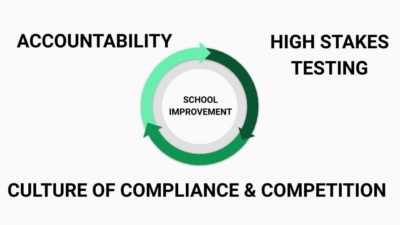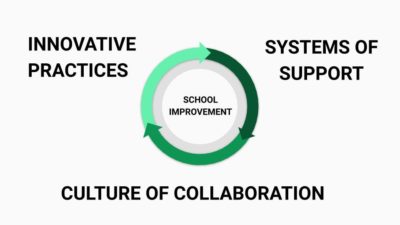Valuing innovation in North Carolina public schools – EducationNC

This is the fifth piece in a week-long series of perspectives on innovative practices in North Carolina public schools. Follow along with the rest of the series here.
The WestEd Report, a comprehensive investigation into the major needs of North Carolina’s public education system as a result of the Leandro case, confirms what many supporters of public education students have been saying for decades. It is time to re-examine school improvement and make policy and practice equitable for all students.
Additionally, the COVID-19 pandemic should remind us all, with a new immediacy, of the potential for our institutions of public education to serve as centerpieces for community-centered, solutions-oriented approaches to an evolving, complex world. As with Hurricane Florence, this disruption to society should serve as the ultimate kick-starter for re-envisioning what we mean by “school” and “education.”
With reconsiderations already pending in North Carolina education for teacher recruitment, retention, and effectiveness, K-3 reading initiatives, the accountability model, and the relationship between charter and traditional schools, rethinking North Carolina’s approach to school improvement could not be more timely.
Fortunately, there are many educators, policymakers, and organizations coming together with an aligned vision and urgency for change. The vision is called innovation. As we have seen from other authors in a series of articles related to innovation supported by the Educational Innovation Network NC and published by EdNC.org over the last few months, innovation is a very broad, complex, and popular term.
The 2019 Burroughs Wellcome Fund Teacher of the Year, Mariah Morris, points out the striking difference between cultures that promote and value innovation, such as at multinational tech-oriented Google, and the culture within PK-12 education in North Carolina, where pursuers of innovation are, more often than not, actually working against a cultural grain. There are those who pursue innovation through new ways of thinking about teacher leadership, such as in Pitt County and as with Team Starfish.
There are communities, like in Edgecombe County, that have used human-centered design to reimagine schools based on student input (check out a mini-documentary on this work here). There are school communities making investments to shift mindsets towards more trauma-informed and socially just practices. There are educators creating experiential learning opportunities outside the boundaries of the classroom’s four walls for their students, as well as advocates whose entire work focuses on diffusing positive culture and climate.
We have heard lessons learned from new innovation roles at the district level, and finally, we have seen a serious glimpse into a more equitable future in computer science careers thanks to open-source, student-centered pedagogical practices.
Innovator Ben Owens identifies the key ingredient for innovation and explores whether an organization is a learning organization. He draws on Peter Senge’s definition of a learning organization — “where new and expansive patterns of thinking are nurtured, where collective aspiration is set free, and where people are continually learning how to learn together.”
We should ask ourselves what policies, structures, and practices we need for our state to operate as an innovative learning organization that Owens describes.
While priority recommendations from the WestEd Report involve funding to ensure that all children have access to early childhood programs and are taught by licensed teachers and principals, there is also the opportunity and priority to rethink school improvement. In an “exploration of school success factors,” the report cites several examples of innovative schools and districts including Franklin County Early College High School, Henderson County Career Academy, and Edgecombe County Public Schools, and Rowan-Salisbury Schools.
E.M. Rogers, in his Diffusion of Innovation model, describes how new ideas get adopted via innovators, early adopters, the early majority, late majority, and laggards. Having an infrastructure to make accessible the early adopters’ innovative practices and programs to a larger majority will be an important step in diffusing what works across schools and districts. This will require that policy is written to reflect a value for cultures that promote innovative thinking and approaches.
A crucial element here is what the organization values, and specifically, what schools and teachers are held accountable for. Fostering innovation will require the General Assembly, the State Board of Education, and the North Carolina Department of Public Instruction to coordinate efforts to lift up teachers’ creativity and expertise and to explore new approaches to the current compliance-driven accountability model.


Advocates of innovation from various educational organizations, leadership roles, and policy-making positions were planned to convene at a public school in the Raleigh area on March 26. This event was organized by the Educational Innovation Network NC and supported by the Watson College of Education.
While our plans are postponed in the interest of public health and safety when we are able to reschedule, the goals of the convening will remain the same: to assess the current status of innovation in North Carolina education by 1) identifying a variety of programs, practices, and initiatives, and 2) identifying core tenets of innovation that are shared across those programs and organizations as well as among educators and leaders. Longer-term possibilities for the work extending from this group include creating a report with recommendations on how to prioritize innovation for PK-12 school improvement (via policy and practice).
The convening, and the momentum that exists currently for support of innovation, should help to ensure an articulated alignment between innovation advocates as the state moves forward with addressing the Leandro action plan.
Robert W. Smith is a faculty member in the Watson College of Education, UNCW, preparing high school teachers. For the last three years, he has served as the Wendy and Dell Murphy Distinguished Professor supporting innovation in PK-12 schools.
Kayce Smith is a coordinator and coach for multi-tiered systems of academic and behavior supports at the best middle school in southeastern North Carolina and a doctoral student in educational leadership within curriculum and instruction at UNC-Wilmington.
